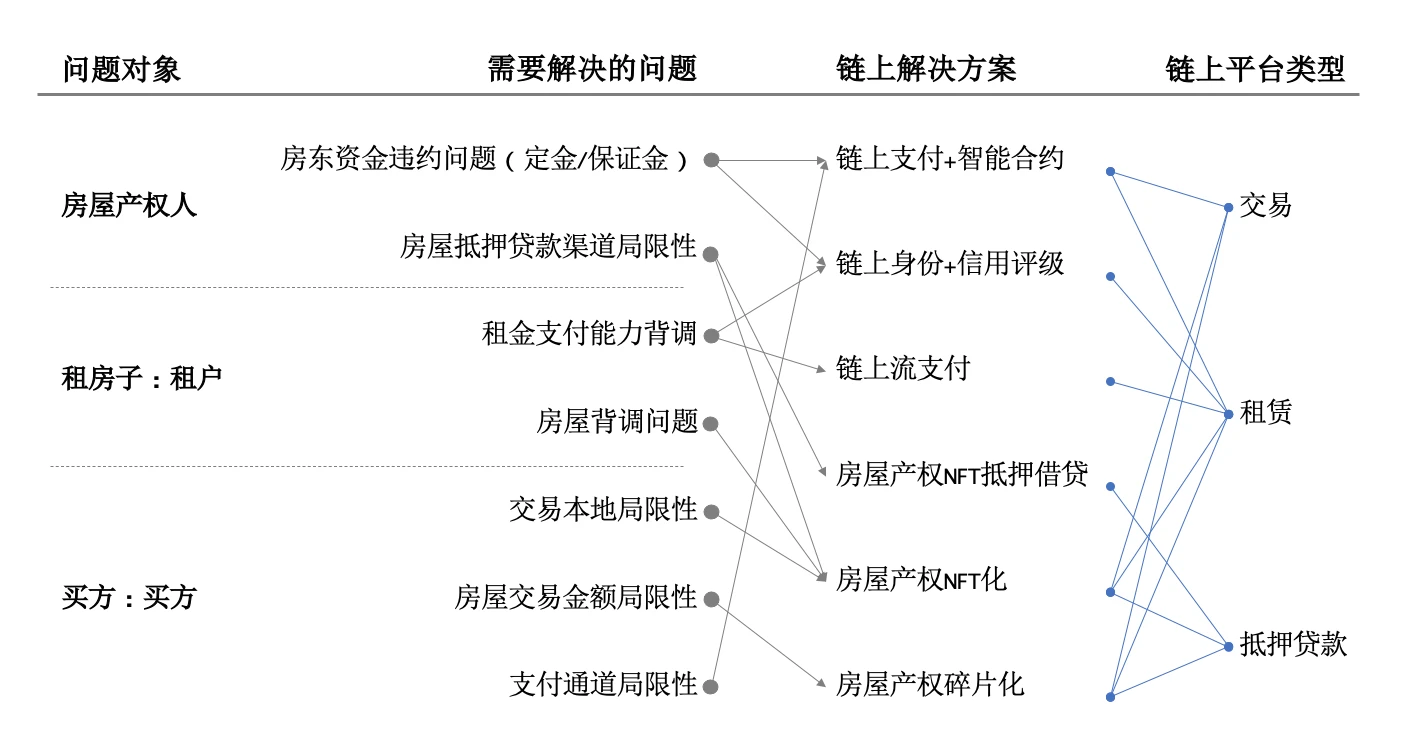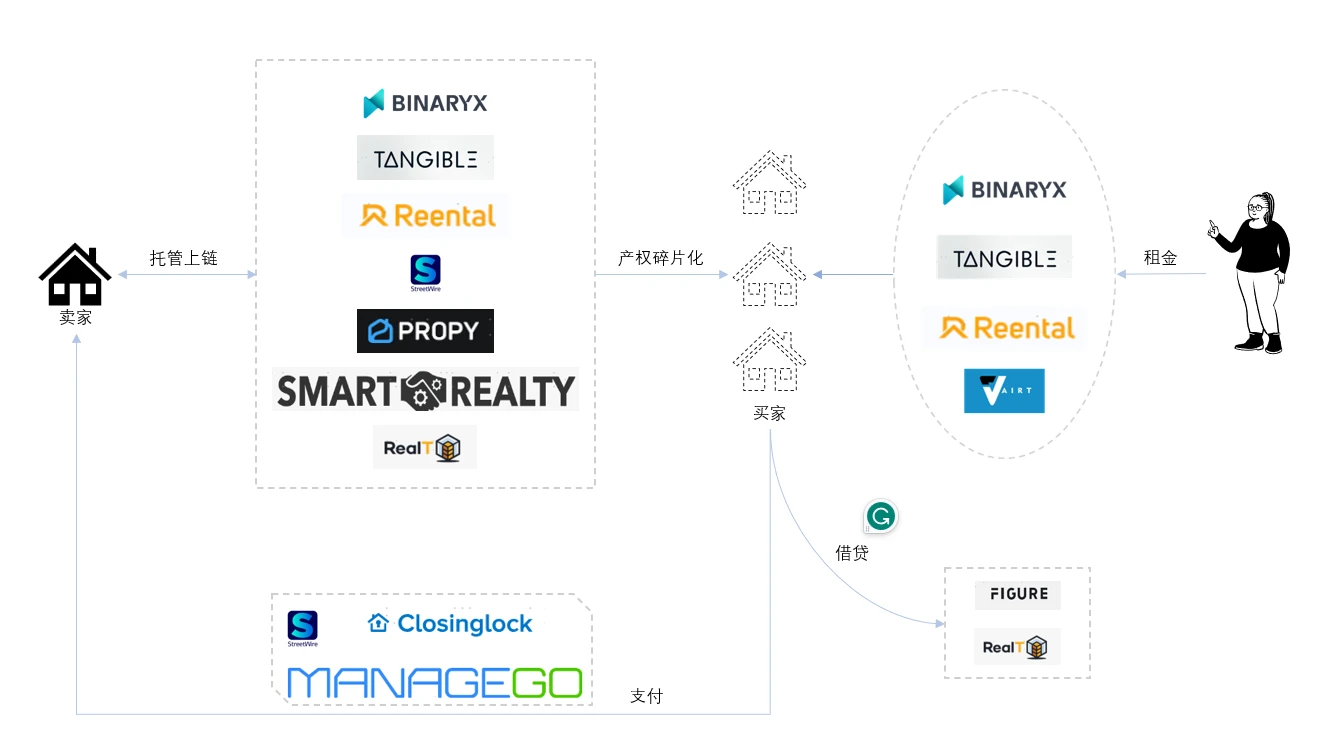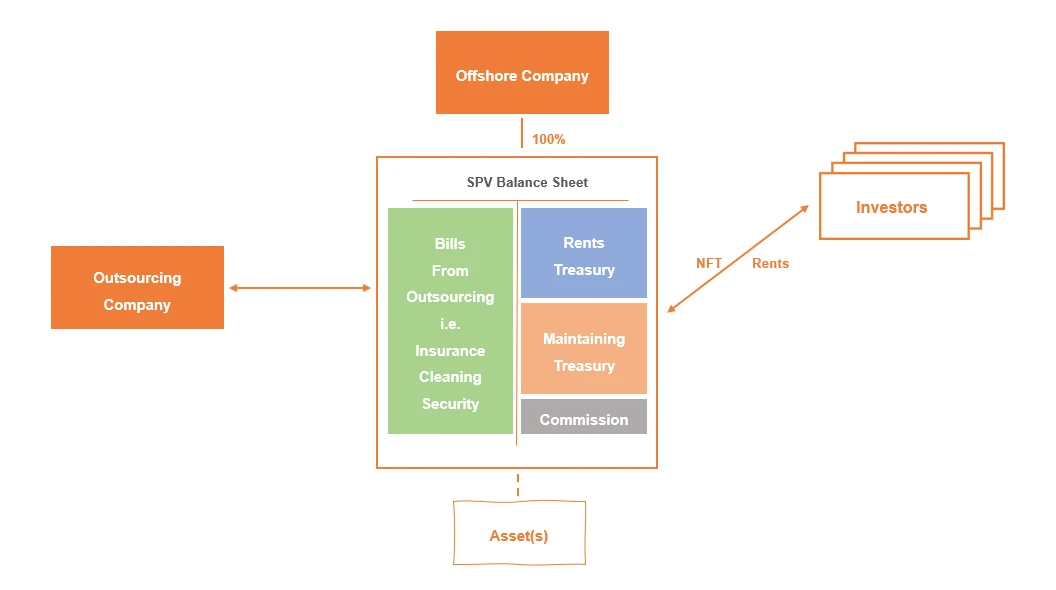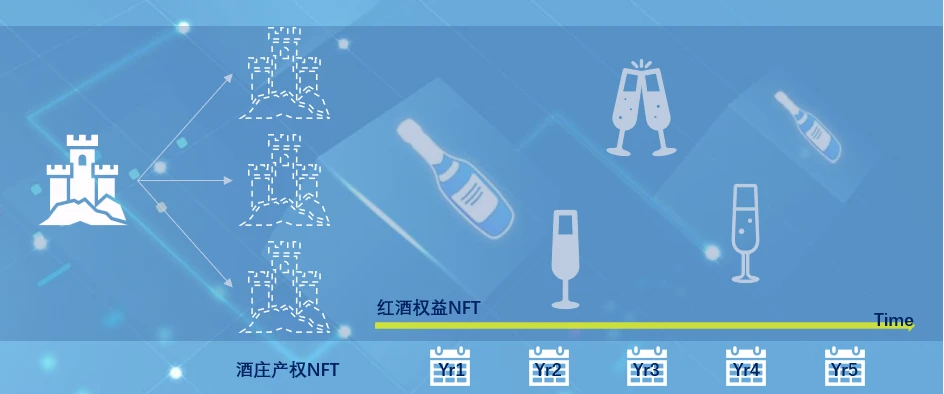Original Author: Jeff@Foresight Ventures
Summary:
On-chain real estate can further split the asset structure and rights of real estate properties. It can separate ownership rights, income rights, and usage rights, all of which can be traded separately. Additionally, on-chain real estate can be split into multiple layers in terms of time scale.
The core issue in the current development of on-chain real estate projects is how to solve the problem of fragmented scenarios during the on-chain process. Platform tokens, decentralized identifiers (DID), and on-chain payment platforms have the potential to become tools for solving this issue.
The current compliance architecture carries potential risks, as there is a lack of solid rights and interests relationship between the NFTs held by buyers and the SPV companies.
It is suggested to explore bridging uncommon asset categories, such as extremely cheap distressed assets and extremely expensive scarce assets. By binding fragmented property rights with NFTs, the real trading needs of buyers and sellers can be addressed.
It is recommended to segment user groups and refine usage scenarios. For example, providing good rental services for digital nomads and leveraging the native characteristics of the web 3.0 gene of this group to create small and beautiful business models.
In the context of the RWA track, the core of innovation lies in the split and recombination of asset structures. The total market capacity of the real estate industry reached $11 trillion in 2022. It is worth paying attention to how to bridge such a huge market onto the blockchain and form a new market ecosystem. This article reviews on-chain real estate projects in the market, identifies common problems, and proposes corresponding hypotheses.
I. On-chain Solution for the South Korean Renting Issue
The housing crisis caused by the full-rental housing system in South Korea has highlighted many problems in the traditional real estate transaction chain. The full-rental housing system allows tenants to use the house without paying rent for a fixed period of time (usually 2 years) after paying a deposit of 60-70% of the total house value to the landlord. Due to the lack of transparent regulatory mechanisms, landlords use the deposit to invest in new properties and continue to exploit the full-rental housing system for cashing out. The real estate market is highly vulnerable in high-leverage situations, and it becomes precarious when there are significant declines in housing prices, loan defaults, and other issues causing a break in the funding chain. Many landlords choose to flee without returning the deposit, leaving tenants with only a small amount of compensation from the debt settlement after the auction, as the deposit only represents the landlord's personal debt.
Can the real estate crisis caused by full-rental housing be avoided through blockchain real estate projects? Here are the main market problems and their corresponding blockchain solutions.
1. Deposit and other fund default issues
Tenants can track the flow of funds and debt situation of landlords by paying the deposit through the blockchain, and they can be alerted in a timely manner to situations where the debt exceeds the value of the property. Smart contracts can also be used to specify the unlocking date of funds and automatically return the deposit or security deposit to the payer.
2. Lack of background check platforms for landlords and tenants, especially for tenants who cannot assess the risk of property mortgage
If property ownership is put on the blockchain and transformed into NFTs, tenants can trace the mortgage status of the property NFT and effectively avoid "high-debt" landlords, reducing unnecessary troubles.
3. In the event of landlord debt default, tenants, who do not hold the property ownership, can only wait for compensation with lower debt priority
If property NFTs are further fragmented into fractional NFTs on the blockchain, tenants can receive the corresponding proportion of property NFTs when paying the deposit and return the corresponding NFTs upon receiving the deposit. In the event of a landlord default that requires liquidation, they can also obtain compensation in proportion to the corresponding property NFTs.
4. Local limitations in the real estate transaction market
By putting property ownership on the blockchain and minting NFTs, the liquidation auction of defaulted properties can be made less geographically restricted, expanding the range of users participating in the transaction from local to all blockchain users.
5. Restrictions on bulk transactions in the real estate market
Most of the rental houses are concentrated in prime locations in Seoul, with their high individual prices deterring ordinary investors. By fractionalizing the ownership NFT, buyers can purchase only a fraction of the fragmented ownership NFT, greatly reducing the investment amount restriction.
2. Target pain points and core links of on-chain real estate projects
Referring to the above example, we have supplemented potential market pain points and issues in the real estate chain, and classified their on-chain solutions and existing on-chain real estate projects into the following three core links for discussion: transaction link, leasing link, and mortgage link.

Figure: Market pain points and on-chain solutions overview
In the transaction link of real estate, the needs of the buyers are often given priority. Existing on-chain real estate projects mainly split ownership and use rights, recombine transaction content with the dimension of time, and try to solve potential market issues through on-chain payments, on-chain identities, ownership NFTs, and their fractionalization.
1. Eliminate the limitations of local transactions, and make house information more real and reliable through on-chain background checks
It is not difficult to understand that on-chain platforms provide global investors with a window of free investment. Platforms like Tangible package ownership into the Special Purpose Vehicle (SPV) in the location of the house and mint all ownership proofs, house information, etc. into house ownership NFTs. Global traders can directly purchase NFTs of the house through their portal website, which represents ownership of the corresponding house. In this process, the Tangible platform advances 10% as a deposit to the seller and then opens subscription to the buyer. The buyer decides whether to purchase after reading the house ownership and information.
2. Prevent assets such as earnest money from not being refunded for default through on-chain payments to ensure fund security
By using on-chain payment for down payments on home purchases, smart contracts can be set up with time constraints, automatically holding the defaulting party accountable for losses. On-chain payment also increases transparency of funds and provides early warning for risks. In the previous description, after Tangible pays the down payment for selling a house, if the agreed-upon subscription is not completed within the specified period, the down payment will be automatically refunded to the Tangible platform.
3. Eliminating limitations on the amount of real estate transactions and lowering the purchase threshold
Users can customize their investment amounts. In order to lower the entry threshold for cross-border real estate purchases, platforms such as RealT split the property rights of houses for a second time. Some platforms fragment the ownership of the property, allowing small-scale investors to voluntarily subscribe to quotas. Others split the property rights and rental income of houses, allowing users to only purchase future rental income for N years. In addition, CityDAO fragments the land ownership by registering as a DAO company, giving buyers not only ownership rights but also governance rights.
4. Eliminating limitations on payment channels
Regulatory issues facing fiat currency transactions also trouble global traders. Therefore, the platforms Smart Reality and ManageGo have specifically opened virtual currency payment channels, where they can escrow the initial funds and even settle directly in virtual currency with the consent of both buyers and sellers. As an intermediary, the transaction platform Closing lock monitors the security of funds and deducts corresponding commissions.
The issues in the rental process mainly revolve around rent collection and housing safety. Currently, rental platforms in the market have not completely migrated the rental activities onto the blockchain. Without exception, the platforms Tangible, BinaryX, and Reental have all adopted a form of outsourcing to web 2.0 companies to ensure that tenants pay rent on time. However, there is more room for exploration in managing rented properties on the blockchain.
1. On-chain rental enables dual background checks on tenant's rent payment ability and landlord's property background
Through on-chain rental, landlords can observe the on-chain dynamics of tenants to determine their asset level and repayment ability, thereby proposing corresponding deposit payment plans. Tenants can also judge the reliability of the property by referring to on-chain property ownership information. Currently, StreetWire is implementing a series of functionalities in this direction.
2. On-chain payment ensures the security of deposits, and stream payment platforms make rent payments obligatory
In the previous case of full-rental housing in South Korea, it was mentioned that on-chain payment of the deposit can protect the interests of tenants through fragmented property ownership. For traditional monthly rental models, stream payment platforms can use smart contracts to enforce timely rent payment by tenants and ensure that the deposit is promptly refunded after the rent expires. On the Sablier platform, we have already seen successful cases of on-chain scheduled rent payments.
3. Fractionalized property NFT makes rental income divisible and combinable
Fractionalized property NFT can distribute collected rental payments to each landlord according to their share of ownership through smart contracts. It can also introduce external adjustment factors to dynamically adjust leasing conditions based on market demand. This way, property NFTs have composability, and users can freely sell "lease contracts" with time limitations. The three rental platforms mentioned earlier, Tangible and others, have already developed the functionality to split rental income. In addition to this model, platforms like Vairt are also attempting to bring short-term rental models to the blockchain to cope with housing vacancies.
The mortgage lending aspect of real estate is still in a market void, with only RealT and FIGURE attempting to offer mortgage lending capabilities for fractionalized property NFTs. However, due to factors such as immature market pricing mechanisms and imbalanced supply relationships, they have not yet gained widespread market recognition. Furthermore, lending platforms aimed at reducing the cost of buying houses are also in a market void, and the market currently lacks Buy Now Pay Later (BNPL) functionality.

Image: Core breakdown of on-chain real estate projects
3. Compliance architecture and asset security
Ensuring the compliance of on-chain property rights is the most important issue I have focused on in my research. Currently, almost all on-chain real estate projects bypass market regulation by adopting an offshore entity holding structure, such as an SPV. I believe that this method is not entirely safe and effective.

Image: Diagram of the blockchain real estate project SPV architecture
Here, we'll take Tangible's compliance solution as an example. The UK properties available on the Tangible platform are held by independent UK SPVs. The offshore entity of the Tangible platform directly controls each SPV company. Fractional ownership of the properties in the form of NFTs is issued and sold to buyers by the SPV entity. To some extent, the transaction security and legality of the properties are protected. However, strictly speaking, the fractional ownership NFTs do not directly represent the equity of the corresponding SPV. If the parent company or SPV encounters debt disputes, since the fractional ownership NFTs cannot directly establish property rights or even correspond to any shares of the offshore companies, buyers may end up with empty hands. The asset security issues intended to be solved through blockchain have been indirectly transferred to the trading platform itself, thus adding additional risks. Additionally, if the fractional ownership NFTs are issued by the SPV company, everything goes back to the regulatory disputes regarding whether tokens should be defined as securities.
From this, it can be seen that the only solution to bypass regulations and ensure asset security is to strengthen the regulation of SPV companies. CityDAO has provided us with a good example in this direction. By registering the company in the form of a DAO, the interests of every NFT holder are ensured. We look forward to seeing how CityDAO performs after breaking through geographical limitations in the future.
So, is there a risk of debt disputes for SPV companies? Yes, especially for default risks in the rental phase of the properties.
1. Reserve Fund Risk: Taking Tangible as an example, the platform deducts a total of 7% of the property's total value as a vacancy reserve fund and maintenance reserve fund. If the reserve fund is lower than the above proportion, 20% of the rental income will be withheld or the rental payment will be suspended to supplement it. The reserve fund is a non-on-chain asset and is not transparent in real operation. Since the SPV company has the right to dispose of the reserve fund, it is highly likely to use the reserve fund to pay the deposit for subsequent auction houses or even for other purposes. Once the property cannot be rented out for a long time and the funds from the sale of other properties are not received in a timely manner, the SPV will face the risk of defaulting on its debt.
2. Mortgage Risk: Since all property rights belong to the SPV company and users cannot monitor in real-time during actual operation, the SPV company may mortgage the property and use the loaned funds for other investments, which also increases the risk of default on debt.
What other problems need to be solved? What could be the solution?
The black box problem in the process of being put on the chain is, in the author's opinion, the most core issue that needs to be addressed. The separation of on-chain and off-chain scenarios has led to the uncertainty of on-chain transactions and leases. This uncertainty directly leads to the following problems:
Problem of scarce high-quality assets: Good houses are easily sold offline, while on-chain properties need background checks before being put on the chain. This additional step may result in lower transaction efficiency compared to offline property agencies. The properties that users can see on the chain are often properties that are difficult to sell offline, or they need to bear costs higher than the market level as a whole. How to improve the efficiency of being put on the chain, and continuously supplement housing resources according to customer needs, is also a problem that needs to be solved.
Actual investment returns are much lower than expected returns: When calculating expected investment returns, the platform considers both the potential increase in property value and rental income as expected returns. However, in the actual operation process, since property rental and management are outsourced to other companies, factors such as rental occupancy rate and tenant default cannot be controlled. In particular, tenant default in Europe is a very difficult problem to handle. If the tenant refuses to pay rent, the landlord can only enforce payment through legal proceedings, a process that may take up to six months. This also means that there will be zero rental income for six months.
Liquidity of properties is trapped on the chain: Properties purchased on the chain are fragmented in terms of ownership. When holders want to sell them, they can only wait for buyers who are willing to purchase equivalent fragmented ownership. Liquidity is relatively limited, and even liquidity can only be trapped on the chain. At the same time, on-chain property mortgage lending is in a vacuum stage in the market and needs to be filled.
In addition to the black box problem, the commercial form of the on-chain real estate platform is not native to web 3. The platform's tokens lack empowerment, making the entire industry awkwardly classified as an on-chain web 2 platform.
Most on-chain real estate platforms do not give tokens any practical use. We hope to increase the functionality of tokens to enhance user stickiness and stimulate the participation of non-investment users. For example, users who browse webpages can also be participants and contributors to the platform, in addition to real estate transaction users.
Excessive reliance on outsourcing companies for leasing results in a lack of user stickiness with the platform. By incorporating purely on-chain transactions into the leasing process, the amount of collateral that users need to pledge can be determined through the combination of user DID and credit accounts. Additionally, by integrating smart contracts to control door locks or power switches, for example, it can prevent users from not vacating upon expiration. Furthermore, the maintenance process can also use the incentive mechanism of crowdsourcing tokens to improve user stickiness.
The platform excessively relies on regional resources. Currently, 90% of on-chain real estate platforms are concentrated in the United States. However, the global real estate transaction volume rankings for 2022 are the United States, Japan, the United Kingdom, and Germany. Few platforms have relevance in the latter countries and regions, and there are limited platforms that can connect to the global trading or leasing markets. I believe that the leasing market is a native scenario for web 3 users and worthy of attention. The following sections will elaborate on this in detail.
IV. Open Ideas for On-Chain Real Estate Projects
Although on-chain real estate projects have many issues mentioned above, the biggest problem is the failure to address users' real needs in a practical manner. However, we maintain a positive and optimistic imagination for this field because there are still many niche scenarios and potential users whose demands have not been adequately met.
High-quality assets in the real estate market often lack liquidity. If we can broaden the category of real estate and reclassify them, we can identify more focused categories. We have listed two categories.
1. Highly priced and scarce immovable properties
Those highly-priced rare real estate properties often discourage ordinary people, such as castles, old houses, wineries, farms, etc. These types of assets are generally unaffordable due to their high individual prices and are not used for daily living needs. Middle-class investors can only admire them without having a good investment opportunity. In the transaction process, these assets also face extremely long transaction periods, resulting in unsatisfactory liquidity. A blockchain platform is a good solution, as it can break down the ownership and usage rights of these assets. Let's take a winery as an example. If the wine production can be separated during the winery transaction process, the ownership of the winery represents a fixed annual amount of wine production. After purchasing the ownership NFT, the buyer can sell the allocated wine production each year, creating an innovative trading market. Through blockchain contracts, the ownership and usage rights are decentralized over the timeline, allowing users to freely combine and trade, forming a non-standardized innovative market. This not only reduces the investment threshold for investors but also significantly improves the liquidity of these types of assets.

Image: Winery ownership and rights NFT concept
2. Extremely cheap distressed assets
These assets are often acquired and restructured by specialized acquisition companies, such as abandoned buildings, dilapidated houses in need of repair, etc. These types of assets often have commercial usage expectations after renovation, but similarly, there is no safe window for ordinary investors to access. A blockchain platform can solve this problem by splitting ownership NFT and rights NFT, reducing the investment threshold for investors and providing a reasonable exit path. For example, in the case of a house in need of repair, if it can be planned as a homestay hotel, investors can enjoy the accommodation rights NFT, which can be sold or used personally in the sales market. At the same time, the entire fundraising process is centralized on the blockchain, making it easier for all investors to monitor the flow of funds and reduce improper project expenses.
Currently, existing blockchain real estate platforms generally do not differentiate users and have a relatively rough scene. Segmenting target users can make the rental track more accurate, align the platform's tone with user needs, and increase frequency of use. We have listed two possible scenarios:
1. The digital nomads are a huge group in the web 3 community, with over 35 million digital nomads worldwide and the number is still growing. Digital nomads often have a strong demand for renting accommodation as they live around the world. However, due to objective factors, they are unable to sign long-term rental contracts and short-term rentals come with high market premiums. I believe that launching an on-chain rental platform specifically for digital nomads would be highly effective. They have a good understanding of the on-chain ecosystem, and most people can trace the source of assets through on-chain activities, which makes it easier to trace the landlord. On-chain rental platforms can also lock deposits through on-chain smart contracts. Users can also evaluate landlords, and using on-chain reputation can effectively constrain both parties by tagging tenants and landlords with their respective DID.

Image: Global distribution map of digital nomads
2. Mobilizing community-based real estate projects and utilizing the "people mine" and the 2 Earn mechanism of the WEB 3 platform to create autonomous communities similar to Anaya and CityDAO is also a new direction. Community members control legal entities through property NFTs, release rights and benefits through platform tokens, and have reasonable autonomous rights. All property rights and benefits can also be sold or even mortgaged through on-chain platforms, creating a new community-based real estate format.
Stay Optimistic
Although it may be too early to discuss on-chain real estate projects at this moment, many problems are difficult to solve in a short period of time. However, in the face of such a huge market capacity and real market demand, I still choose to stay optimistic. I believe that on-chain real estate projects can bring innovative market ecosystems.
About Foresight Ventures
Foresight Ventures is betting on the innovation journey of cryptocurrencies for the next few decades. It manages multiple funds: VC Fund, Secondary Active Management Fund, Multi-strategy FOF, Special Purpose S Fund "Foresight Secondary Fund l", with total assets under management exceeding $400 million. Foresight Ventures adheres to the concept of "Unique, Independent, Aggressive, Long-term" and provides extensive support to projects through its strong ecosystem. Its team consists of senior professionals from top financial and technology companies, including Sequoia China, CITIC Securities, Google, Bitmain, etc.
Website: https://www.foresightventures.com
Disclaimer: All articles from Foresight Ventures are not intended as investment advice. Please assess your individual risk tolerance and make investment decisions prudently.










